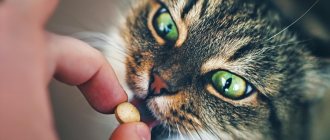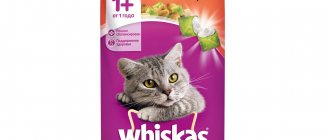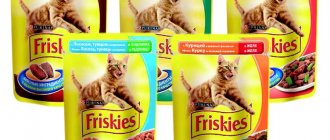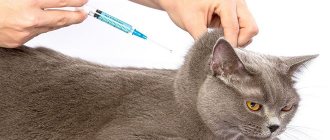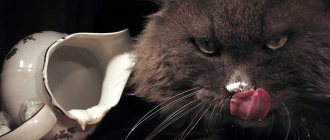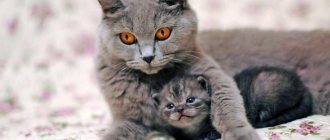What will you learn from the article?
- Why is taurine needed for cats? What does taurine deficiency lead to?
- Symptoms of Taurine Deficiency
- What does an overdose lead to?
- Taurine in natural foods
Taurine is a sulfur-containing amino acid that is present in bile and other tissues of living organisms. Taurine for cats is an essential element, without which the animal cannot live and fully develop. In most mammals, taurine is synthesized in the body; nature has not endowed cats with this ability. Their body vitally needs taurine, but does not know how to “produce” it.
Why nature distributed it this way, what is the importance of taurine for cats, where do they get it in the wild and at home - we will answer these and other questions in this article.
Why do cats need taurine?
Taurine is an amino acid that helps cells produce proteins necessary for the proper functioning of the cat's body. Participates in the formation of bile to digest fats in the small intestine, reduce cholesterol and blood pressure. The benefit of the amino acid lies in its assistance in metabolic processes, storage and transportation of nutrients. The element is needed to control blood sugar levels, maintain the health of the urinary system, and visual organs.
Cats, unlike humans and dogs, do not produce taurine. The amino acid must be supplied to them with food.
In cats, the need for taurine is 400 mg per 1 kg of body weight.
If you do not receive enough of this acid, your health begins to deteriorate over time. Deficiency develops between 5 months and 2 years. The process is long and symptoms do not appear externally.
Dosage regimen for cats
Manufacturers always include detailed instructions for taurine supplements in tablet form, which clearly indicate the dosage and frequency of its use. Before starting to use any supplement, you should first discuss this with your veterinarian.
General guidelines for taking amino acid supplements for cats are as follows:
- The nutritional supplement is allowed to be given to cats two months and older. Taurine for kittens up to two months is found in their mother's milk.
- Reception occurs daily, once a day.
To calculate the dosage for a kitten, the following formula is usually used: one tablet is needed per kilogram of weight. The course of treatment is four to five weeks. Adult cats are usually prescribed three to six tablets per five kilograms of body weight. The course of treatment is from two to four weeks. It is recommended to give kitties taurine supplements in the fall and spring. This is quite enough for the cat’s body to be completely healthy.
A common problem for cat owners is their pet's refusal to swallow pills. To ease your cat's fate, you can:
- grind the pill into powder and mix with wet food;
- if the cat is “natural”, crushed taurine tablets are added to the cottage cheese or porridge.
If this does not work, you need to forcefully place a taurine tablet directly on the root of the Kisuli tongue. Reflexively, she will immediately swallow it.
What does taurine deficiency lead to?
Sulfonic acid is concentrated in high proportions in the heart, brain, and retina. Therefore, these organs suffer the most from amino acid deficiency. If there is not enough taurine in the feed, the reserves of this amino acid in the tissues begin to gradually be used up. It all starts with plasma and blood, then muscles, retina, and nervous tissue are involved.
When “complete” industrial feeds first began to be produced (60s of the 20th century), animals feeding on them lost their eyesight and experienced heart problems. Research has found that the reason is the lack of taurine in the feed.
What is taurine and what role does it play in cat food?
Taurine contains an amino group and sulfur - C₂H₇NO₃S.
An acid that contains an amine group and sulfur is necessary for the functioning of the following systems, organs and tissues:
- retina;
- heart muscle;
- fertilization and gestation of the embryo;
- digestion, as it is necessary for the production of bile;
- immune system, which ensures good health and protection against infections.
Symptoms of Taurine Deficiency
There are no direct symptoms of taurine deficiency. All signs are associated with developing diseases, primarily dilated cardiomyopathy and retinal degeneration. Therefore, differential diagnosis with these diseases is carried out.
If a plasma analysis shows a taurine content of less than 25 nmol/ml, then they speak of taurine deficiency. In healthy cats, this figure is 50 nmol/ml or higher. However, the result is influenced by how much amino acid was supplied with food before the study or by prolonged fasting. Therefore, it is difficult to judge from the result how much substance the animal lacks. More accurate data is shown by whole blood analysis. A cat is healthy if the taurine level in whole blood is 250 nmol/ml or higher. If it is lower, a deficiency is diagnosed.
What does an overdose lead to?
An excess of taurine in cats is rare. More often in kittens. Leads to muscle weakness and the development of chest pathology - funnel chest.
Prevention measures
The risk of a negative immune system reaction is reduced if the owner adheres to the following rules:
- introducing cat food gradually so that the owner can identify the cause of the allergic reaction;
- use only high-quality meats;
- carefully read the instructions for dry food, which should not contain carcinogenic chemical additives;
- promptly treat various infections, viruses, parasitic diseases;
- eliminating household allergens, such as dust, chemicals, household items;
- To prevent the development of chicken allergies in cats, it is better to feed rabbit or beef.
Allergy is an unpleasant phenomenon that can manifest itself in both a kitten and an adult. It is easier to promptly detect emerging negative manifestations than to treat further disorders. Therefore, there are rules of prevention that allow you to avoid an increased reaction of the animal’s immune system.
How to fix the situation
Cats begin to replenish taurine by correcting their diet. The animal is switched to premium and super premium food, or meat and fish are introduced into the diet. The transition to a new type of food or a new brand of food is carried out gradually, over 2 weeks, to avoid stomach and intestinal upset.
But in addition to replenishing the diet with amino acids, tablets or powders are additionally prescribed. For example, Debikor. The dose for a cat is 250 mg twice a day. The course is at least 3 months. The “excess” substance, which is not absorbed by the body, is excreted in the urine without causing harm to health. The animal's condition returns to normal within 1-2 weeks.
Vitamin deficiency
If this vitamin is absent from the cat’s body for a long time, a number of negative factors may arise. First of all, vision problems appear. The animal begins to see much worse and is poorly oriented in space. Digestive problems may be noticed. After each meal, as a rule, the gag reflex is actively manifested. Obvious signs are diarrhea or constipation. The most dangerous symptom is heart failure, accompanied by general weakness, drowsiness and malaise.
If such ailments are observed, then you should immediately introduce vitamins with taurine for cats into the diet. A lack of it can lead to the development of serious diseases. In some cases it is a harbinger of death.
Where is taurine found?
Most taurine is found in meat, liver, heart, and kidneys. Found in small quantities in dairy products and eggs. Plant products practically do not contain this substance. The highest concentrations are in raw meat and fish. During heat treatment, the taurine contained in them is destroyed. The leaders in amino acid levels are turkey meat and tuna fish.
| Product | Amino acid level (mg/100g) | % of daily norm |
| Dark meat turkey | 360 | 77 |
| Tuna (raw fish) | 280 | 71 |
| Chicken (dark meat) | 170 | 43 |
| Raw red fish | 130 | 33 |
| Chicken heart and liver | 117 | 30 |
Taurine in industrially produced cat food is guaranteed to be in the “premium” and “super premium” classes. In industrial economy class feeds, the additive is minimal or absent.
If the animal eats vegetarian food or the composition contains cereals in the first place, then the cat does not receive acid in the required volume. She needs supplements.
The study determined the minimum level of taurine in cat food:
- For dry granules - 1 -1.2 g per 1 kg of feed (0.1-0.12%).
- For canned food - no less than 1.7 g, and better - 2-2.5 g per 1 kg (0.2-0.25%).
It has been scientifically proven that even a dose of 10 g of taurine per kilogram of feed is safe for animals.
Diagnostics
The diagnosis of taurine deficiency can be made by a veterinarian after a physical examination of the cat. Diagnostics may include the following research methods:
- general blood analysis;
- general urine analysis;
- biochemical blood test;
- electroretinogram - examination of the retina of the eye;
- ECG.
If taurine deficiency is suspected, your cat may have an electrocardiogram.
Best Taurine Supplements
Taurine is available in the form of powder, tablets, solutions, and dragees. The doctor will tell you which feed additive to choose for your pet, focusing on the animal’s health, age, and physiological characteristics.
The following feed additives are considered good:
- Beaphar's Top 10 is a multivitamin supplement containing essential vitamins, minerals and amino acids. It has a shrimp flavor and is well eaten by cats. This is a big plus, since giving a pill to a cat is not easy and is a real stress for the pet. Weakness, lethargy, bad mood - indications for using Top 10.
- Omega NEO - a multivitamin delicacy contains mussels, seaweed, squid liver - components rich in Omega-3 essential fatty acids, taurine, biotin and vitamins. The smell and taste of the treat is attractive to cats. The palatability is excellent.
- Canina Taurin – available in powder form for mixing into food. Suitable for any type of food. The Kanina company produces a vitamin gel, which can also be added to canned food or taken from a syringe.
- Ceva is an inexpensive multivitamin tablet with taurine and biotin. There are supplements for adults and kittens. They are used both as a feed additive and as a treat to reward cats.
- GimPet - the company produces vitamins in fancy shapes: mice, hearts, pads, etc. A variety of Schnurries - heart-shaped vitamins for cats. According to reviews from cat breeders, multi-colored hearts have become favorites for many cats. Pets also love Topinis “mice” with cottage cheese, milk, salmon, chicken - they all contain taurine.
- Doctor Zoo is a line of various food additives. Vitamins “Health and Beauty” and “Health of Skin and Coat” are produced with taurine. Suitable for any method of nutrition.
Features of application
Taurine for cats can be found in two main forms: drops and tablets.
The first option is intended for the treatment of retinal diseases. One drop should be instilled 2-3 times a day. Naturally, the animal will resist, so it is recommended to firmly fix its body. The general course of treatment lasts three months. If during this time the problem cannot be eliminated, then you can repeat the procedures after a two-week break.
The dosage in tablets is determined by a specialist, depending on the degree of deficiency of this vitamin in the body. It is almost impossible to force a cat to eat medicine. It is recommended to add it to food or dilute it with a small amount of water.
Congestive heart failure
Taurine is approved for use in the treatment of congestive heart failure (CHF) in Japan [17]. Like other drugs used to treat CHF, taurine not only reduces symptoms (exertional dyspnea and edema) but also eliminates or reduces the need for other drugs such as digoxin [17]. Taurine has a moderate positive inotropic effect and promotes natriuresis and diuresis, but its main therapeutic effect when taken chronically is to reduce the action of norepinephrine and angiotensin II, which play a role in reducing myocardial performance through increasing afterload pressure, ventricular remodeling and fluid redistribution. Taurine effectively reduces the unwanted effects of norepinephrine through its ability to reduce excess catecholamines (via changes in Ca2+ transport) and attenuate cell signaling (via changes in Ca2+ transport, reactive oxygen species and protein phosphorylation). Although recent studies have shown improvements in exercise capacity in patients with CHF with taurine use [18], it remains unknown whether taurine reduces the risk of heart failure in the general population. In addition, the reduction of mortality rates in patients with CHF when taking taurine has not been studied. There is evidence to suggest that taurine may prolong the lifespan of patients with CHF because it increases the myocardial high-energy phosphate content, which is an important determinant of mortality among patients with CHF [8].
Literature
- Ginguay A., De Bandt JP, Cynober L. Indications and contraindications for infusing specific amino acids. (leucine, glutamine, arginine, citrulline and taurine) in critical illness. Curr Opin Clin Nutr Metab Care. 2016;19:161−169. DOI:10.1097/ MCO.0000000000000255.
- McCarty MF Nutraceutical strategies for ameliorating the toxic effects of alcohol. Med Hypotheses. 2013;80:456−462. DOI:10.1016/j.mehy.2012.12.040.
- Yamori Y., Murakami S., Ikeda K., Nara Y. Fish and lifestyle-related disease prevention: experimental and epidemiological evidence for anti-atherogenic potential of taurine. Clin Expt Pharmacol Physiol. 2004;31:S20−S23. DOI:10.1111/j.1440–1681.2004.04122.x.
- Sagara M., Murakami S., Mizushima S. et al. Taurine in 24-h urine samples is inversely related to cardiovascular risks of middle aged subjects in 50 populations of the world. Adv Exp Med Biol. 2015;803:623−636. DOI:10.1007/978–3-319–15126–7_5.
- Rosa FT, Freitas EC, Deminice R. et al. Oxidative stress and inflammation in obesity after taurine supplementation: a double-blind placebo-controlled study. Eur J Nutr. 2014;53:823−830. DOI:10.1007/s00394–013–0586–7.
- Kim C., Cha YN Taurine chloramine produced from taurine under inflammation provides anti-inflammatory and cytoprotective effects. Amino Acids. 2014;46:89−100. DOI:10.1007/s00726–013–1545–6.
- Schaffer SW, Jong CJ, Ito T. et al. Role of taurine in the pathogenesis of MELAS and MERRF. Amino Acids. 2014;46:47−56. DOI:10.1007/s00726–012–1414–8.
- Schaffer SW, Shimada-Takaura K, Jong CJ et al. Impaired energy metabolism of the taurine-deficient heart. Amino Acids. 2016;48:549−558. DOI:10.1007/s00726–015–2110–2.
- Ricci C., Pastukh V., Leonard J. et al. Mitochondrial DNA damage triggers mitochondrial superoxide generation and apoptosis. Am J Physiol. 2008;294:C413− C422. DOI:10.1152/ajpcell.00362.2007.
- Rikimaru M., Ohsawa Y., Wolf AM et al. Taurine ameliorates impaired mitochondrial function and prevents stroke-like episodes in patients with MELAS. Intern Med. 2012;51:3351−3357. DOI:10.2169/internalmedicine.51.7529.
- Park SH, Lee H., Park K. et al. Taurine-induced changes in transcription profiling of metabolism-related genes in human hepatoma cells HepG2. Adv Exp Med Biol. 2006;583:119−128. DOI:10.1007/978–0-387–33504–9_12.
- Ramila KC, Jong CJ, Pastukh V. et al. Role of protein phosphorylation in excitationcontraction coupling in taurine deficient hearts. Am J Physiol. 2015;308:H232−H239. DOI:10.1152/ajpheart.00497.2014.
- Ito T., Miyazaki N., Schaffer S. et al. Potential antiaging role of taurine via proper protein folding: a study from taurine transporter knockout mouse. Adv Exp Med Biol. 2015;803:481−487. DOI:10.1007/978–3-319–15126–7_38.
- Jong CJ, Ito T., Schaffer SW The ubiquitin-proteasome system and autophagy are defective in the taurine-deficient heart. Amino Acids. 2015;47:2609−2622. DOI:10.1007/ s00726–015–2053–7.
- Bai J., Yao X., Jiang L. et al. Taurine protects against As2O3-induced autophagy in livers of rat offspring through PPARΥ pathway. Sci Rep. 2016;6:27733. DOI:10.1038/ srep27733.
- Schaffer SW, Solodushko V., Kakhniashvili D. Beneficial effect of taurine depletion on osmotic sodium and calcium loading during chemical hypoxia. Am J Physiol. 2002;282:C1113−C1120. DOI:10.1152/ajpcell.00485.2001.
- Azuma J., Sawamura A., Awata N. Usefulness of taurine in chronic congestive heart failure. Jp Circ J 1992;56:95−99. DOI:10.1253/jcj.56.95.
- Ahmadian M., Roshan D., Ashourpore E. Taurine supplementation improves functional capacity, myocardial oxygen consumption and electrical activity in heart failure. J Diet Suppl. 2017;14:422−432. DOI:10.1080/19390211.2016.1267059.
- Hu J., Xu X., Yang J. et al. Antihypertensive effect of taurine in rat. Ad Exp. Med Biol. 2009;643:75−84. DOI:10.1007/978–0-387–75681–3_8.
- Katakawa M., Fukuda N., Tsunemi A. et al. Taurine and magnesium supplementation enhances the function of endothelial progenitor cells through antioxidation in healthy men and spontaneously hypertensive rats. Hypertens Res. 2016;39:848−856. DOI:10.1038/hr.2016.86.
- Sun Q., Wang B., Li Y. et al. Taurine supplementation lowers blood pressure and improves vascular function in prehypertension: randomized, doubleblind, placebo controlled study. Hypertension. 2016;67:541−549. DOI:10.1161/ HYPERTENSIONAHA.115.06624.
- Yamori Y., Taguchi T., Hamada A. et al. Taurine in health and diseases: consistent evidence from experimental and epidemiological studies. J Biomed Sci. 2010;17:S6. DOI:10.1186/1423–0127–17-S1-S6.
- Ogawa M., Takahara A., Ishijima M. et al. Decrease of plasma sulfur amino acids in essential hypertension. Jpn Circ. 1985;J.49:1217−1224. DOI:10.1253/jcj.49.1217. A complete list of references can be found on the website https://www.rmj.ru
- Murakami S., Sakurai T., Tomoike H. et al. Prevention of hypercholesterolemia and atherosclerosis in the hyperlipidemia- and atherosclerosis-prone Japanese (LAP) quail by taurine supplementation. Amino Acids. 2010;38:271−278. DOI:10.1007/s00726–009–0247–6.
- Yanagita T., Han S.Y., Hu Y. et al. Taurine reduces the secretion of apolipoprotein B100 and lipids in HepG2 cells. Lipids Health Dis. 2008;7:38. DOI:10.1186/1476–511X-7–38.
- Ulrich-Merzenich G., Zeitler H., Vetter H. et al. Protective effects of taurine on endothelial cells impaired by high glucose and oxidized low density lipoproteins. Eur J Nutr. 2007;46:431−438. DOI:10.1007/s00394–007–0682–7.
- Zulli A., Lau E., Wijaya BPP et al. High dietary taurine reduces apoptosis and atherosclerosis in the left main coronary artery. Hypertension. 2009;53:1017−1022. DOI:10.1161/HYPERTENSIONAHA.109.129924.
- Yoshimura H., Nariai Y., Etshima M. et al. Taurine suppresses platelet-derived growth factor (PDGF) BB-induced PDGF-beta receptor phosphorylation by protein tyrosine phosphatase-mediated dephosphorylation in vascular smooth muscle cells. Biochim. Biophys Acta. 2005;1745:350−360. DOI:10.1016/j.bbamcr.2005.07.005.
- Gokce G., Ozsarlak-Sozer G., Oran I. et al. Taurine suppresses oxidative stresspotentiated expression of lectin-like oxidized low-density lipoprotein receptor and restensosis in balloon-injured rabbit iliac artery. Clin Expt Pharmacol Physiol. 2011;38:811−818. DOI:10.1111/j.1440–1681.2011.05612.x.
- Yamori Y., Liu L., Ikeda K. et al. Distribution of twenty-four hour urinary taurine excretion and association with ischemic heart disease mortality in 24 populations of 16 countries: results from the WHO-CARDIAC study. Hypertens Res. 2001;24:453−457. DOI:10.1291/hypres.24.453.
- Elvevoll EO, Eilertsen KE, Brox J. et al. Seafood diets: and antiatherogenic effects of taurine and n-3 fatty acids. Atherosclerosis. 2008;200:396−402. DOI:10.1016/j. atherosclerosis.2007.12.021.
- Sahin M.A., Yucel O., Guler A. et al. Is there any cardioprotective role for taurine during cold ischemic period following global myocardial ischemia? J Cardiothorac Surg. 2011;6:31. DOI:10.1186/1749–8090–6-31.
- Eby G., Halcomb WW Elimination of cardiac arrhythmias using oral taurine with L-arginine with case histories: hypothesis for nitric oxide stabilization of the sinus node. Med Hypotheses. 2006;67:1200−1204. DOI:10.1016/j.mehy.2006.04.055.
- Schaffer SW, Jong CJ, Warner D. et al. Taurine deficiency and MELAS are closely related syndromes. Adv Exp Med Biol. 2013;776:153−165. DOI:10.1007/978–1-4614–6093–0_16.
- Kirino Y., Goto Y., Campos Y. et al. Specific correlation between the wobble modification deficiency in mutant tRNAs and the clinical features of a human mitochondrial disease. Proc Natl Acad Sci. USA 2005;102:7127−7132. DOI:10.1073/ pnas.0500563102.
- Zheng Y., Ceglarek U., Huang T. et al. Plasma taurine, diabetes genetic predisposition, and changes in insulin sensitivity in response to weight-loss diets. J Clin Endocrinol Metabol. 2016;101:3820−3826. DOI:10.1210/jc.2016–1760.
- Schaffer SW, Azuma J., Mozaffari M. Role of antioxidant activity of taurine in diabetes. Can J Physiol Pharmacol. 2009;87:91−99. DOI:10.1139/Y08–110.
- Han X., Patters AB, Ito T. et al. Knockout of the TauT gene predisposes C57BL/6 mice to streptozotocin-induced diabetic nephropathy. PLoS ONE. 2015;10:e0117718. DOI:10.1371/journal.pone.0117718.
- Kim KS, Oh DH, Kim JY et al. Taurine ameliorates hyperglycemia and dyslipidemia by reducing insulin resistance and leptin level in Otsuka Long-Evans Tokushima fatty. (OLETF) rats with long-term diabetes. Exp Mol Med. 2012;44:665−673. DOI:10.3858/ emm.2012.44.11.075.
- Sivitz WI, Yorek MA Mitochondrial dysfunction in diabetes: from molecular mechanisms to functional significance and therapeutic opportunitiees. Antioxid. Redox Signal. 2010;12:537−577. DOI:10.1089/ars.2009.2531.
- Haber CA, Lam TK, Yun Z. et al. N-acetylcysteine and taurine prevent hyperglycemia-induced insulin resistance in vivo: possible role of oxidative stress. Am J Physiol. 2003;285:E744−E753. DOI:10.1152/ajpendo.00355.2002.
- Trachtman H., Futterweit S., Maesaka J. Taurine ameliorates chronic streptozocin-induced diabetic nephropathy in rats. Am J Physiol. 1995;269:F429−F438. DOI:10.1152/ajprenal.1995.269.3.F429.
- Ikubo N., Saito M., Tsounapi P. et al. Protective effect of taurine on diabetic rat endothelial dysfunction. Biomed Res. 2011;32:187−193. DOI:10.2220/biomedres.32.187.
- Murakami S. Role of taurine in the pathogenesis of obesity. Mol Nutr Food Res. 2015;59:1353−1363. DOI:10.1002/mnfr.201500067.
Contraindications, harm, overdose
Vitamins for cats containing taurine, according to the instructions for use, are safe. The only contraindication is amino acid intolerance, manifested by indigestion, vomiting, and skin rash. If your pet develops similar symptoms, you need to visit a veterinarian to select an appropriate diet. When your cat is given medications or nutritional supplements, your veterinarian should also be consulted about their compatibility with sulfonic acid. Negative symptoms associated even with a significant excess of the required amount of amino acid are not frequent. Taurine ingested in excess by a cat is not harmful, since the excess substance is excreted in the urine.
